SPRING ROSE PRUNING GUIDE
(taken from Portland Rose Chatter, February 2004)
As the month of February progresses, gardeners begin to get anxious, in particular the rose gardener who wants to get out and prune the roses.
Pruning roses is really a rather simple process, but a process which is hard to put into words. Every experienced rose grower will describe the technique slightly differently and probably does it slightly differently. One important fact to remember is that no matter how you prune, unless you cut the rose off below the ground line, it will survive and bloom. A total lack of pruning is worse for the bush than any amount of over pruning you may do. So prune with confidence and the results will be good.
To learn more about pruning roses, attend one of the pruning demonstrations presented by the PRS where can ask specific questions, (the schedule of pruning demonstrations is in the PRS calendar), but for those who cannot attend, the following information should suffice as a guide to pruning roses competently and with confidence.
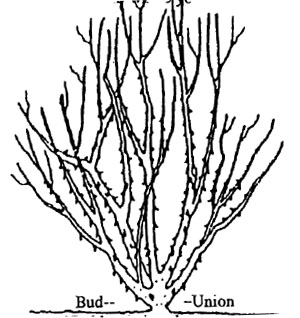 Begin pruning by just looking closely at the rose bush, a typical example of which is depicted in the diagram to the right (you will probably have no bushes that look exactly like this example). Every rose bush in the garden will have grown differently during the past season so begin by carefully looking at what you have to start with. This is a very important part of the process. This first part of the examination should be directed toward the lower part of the rose bush, the area from which the canes (rose stems) originate, which is called the bud union. The purpose of pruning is to remove all weak growth, leaving only strong, healthy canes which can adequately support the growth expected during the upcoming summer. When the pruning is done, a good bit of the uppermost parts of the bush will be removed. This pining concept is true for hybrid teas, floribunda and miniature roses. Climbers, nonremontant, (once flowering varieties), and old garden roses are pruned a little differently and their pruning will be discussed later. Begin pruning by just looking closely at the rose bush, a typical example of which is depicted in the diagram to the right (you will probably have no bushes that look exactly like this example). Every rose bush in the garden will have grown differently during the past season so begin by carefully looking at what you have to start with. This is a very important part of the process. This first part of the examination should be directed toward the lower part of the rose bush, the area from which the canes (rose stems) originate, which is called the bud union. The purpose of pruning is to remove all weak growth, leaving only strong, healthy canes which can adequately support the growth expected during the upcoming summer. When the pruning is done, a good bit of the uppermost parts of the bush will be removed. This pining concept is true for hybrid teas, floribunda and miniature roses. Climbers, nonremontant, (once flowering varieties), and old garden roses are pruned a little differently and their pruning will be discussed later.
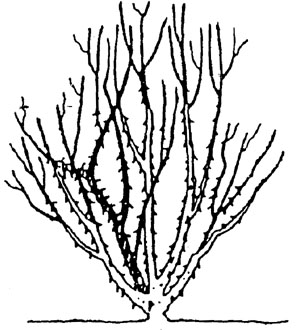 In studying the bottom of the bush, identify the youngest and strongest canes. These can be identified by their color, texture an size. Young canes, one or two years old, are usually green in color and have a relatively smooth outer surface. As a cane ages it will usually become darker or grey-brown in color as it develops bark. Aging canes also become rough in texture due to the cracking and peeling of the outer bark. With hybrid tea roses, canes which are easily identified as being old, are generally not very productive and should be entirely removed by cutting them off at the bud union (their origin) using loppers or a pruning saw. (See the darkened cane in the illustration to the right.) A non-productive older cane can be identified by looking at last year’s growth emanating from it. If all of the growth was small and twiggy, it is a good sign that this is a cane that should be removed because it is no longer able to produce vigorous new growth. In studying the bottom of the bush, identify the youngest and strongest canes. These can be identified by their color, texture an size. Young canes, one or two years old, are usually green in color and have a relatively smooth outer surface. As a cane ages it will usually become darker or grey-brown in color as it develops bark. Aging canes also become rough in texture due to the cracking and peeling of the outer bark. With hybrid tea roses, canes which are easily identified as being old, are generally not very productive and should be entirely removed by cutting them off at the bud union (their origin) using loppers or a pruning saw. (See the darkened cane in the illustration to the right.) A non-productive older cane can be identified by looking at last year’s growth emanating from it. If all of the growth was small and twiggy, it is a good sign that this is a cane that should be removed because it is no longer able to produce vigorous new growth.
An older cane that has large healthy looking secondary canes coming from it is usually still productive and should be saved. Stumps of canes left protruding from the bud union after pruning are unattractive and provide ideal places and conditions for the colonization by certain disease organisms, so when removing a cane try very bard to get the entire cane and leave as short of a stump as possible, or ideally none.
Next, remove any of the younger canes which cross the middle of the bush. These canes should either be removed entirely back to the bud union, or back to the major cane from which they originated.
Growth from crossing canes will become intertwined, with the net result being few quality flowers. Then remove canes which are crowded close to each other, generally leaving the larger one of each crowded pair. Finally, if there is any twiggy growth remaining anywhere on the bush, remove it back to its point of origin. (All of the dark colored areas on the bush in the illustration would be removed to achieve the desired effect.)
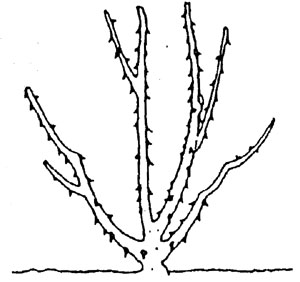 When the pruning is finished, the ideal rose bush will have only sturdy, healthy canes radiating from the bud union. In reality, this ideal is rarely achieved. Most bushes do not have enough canes growing in just the right directions to be ideal. If the bush has only 2, 3 or 4 canes, it would be best to allow them all to remain, unless one of them is truly a nonproductive old cane. If the rose has 5 to 7 or more canes, you can then begin making decisions about which ones to remove to achieve a pleasing balance. For most rose bushes, an outcome similar to the diagram on the right would be desirable. Also at this time, remove any old leaves still clinging to the rose plant because leaves which have over-wintered will often be disease carriers. These leaves should come off easily with a slight pull. Finally, spray the newly pruned bushes with a fungicide such as Funginex, Daconil, etc. However, do not apply any dormant sprays at this time. The most common sprays intended for dormant use (I no longer recommend the use of any dormant sprays due to lack of efficacy) contain sulfur at concentrations that will damage any of the young buds that have begun to break dormancy. Many of this year’s disease problems will begin when the buds first begin to grow, which they are probably already doing. Fungus spores which have over-wintered on the canes and under the vegetative bud scales, will reinfect the bush as the buds begin to break, unless a preventative fungicidal spray is used. Spraying with fungicides should be repeated at 10 day to two week intervals during wet or damp weather to help maintain disease free bushes as the month of February progresses. When the pruning is finished, the ideal rose bush will have only sturdy, healthy canes radiating from the bud union. In reality, this ideal is rarely achieved. Most bushes do not have enough canes growing in just the right directions to be ideal. If the bush has only 2, 3 or 4 canes, it would be best to allow them all to remain, unless one of them is truly a nonproductive old cane. If the rose has 5 to 7 or more canes, you can then begin making decisions about which ones to remove to achieve a pleasing balance. For most rose bushes, an outcome similar to the diagram on the right would be desirable. Also at this time, remove any old leaves still clinging to the rose plant because leaves which have over-wintered will often be disease carriers. These leaves should come off easily with a slight pull. Finally, spray the newly pruned bushes with a fungicide such as Funginex, Daconil, etc. However, do not apply any dormant sprays at this time. The most common sprays intended for dormant use (I no longer recommend the use of any dormant sprays due to lack of efficacy) contain sulfur at concentrations that will damage any of the young buds that have begun to break dormancy. Many of this year’s disease problems will begin when the buds first begin to grow, which they are probably already doing. Fungus spores which have over-wintered on the canes and under the vegetative bud scales, will reinfect the bush as the buds begin to break, unless a preventative fungicidal spray is used. Spraying with fungicides should be repeated at 10 day to two week intervals during wet or damp weather to help maintain disease free bushes as the month of February progresses.
How low should hybrid tea roses be pruned? Again, every experienced rose grower will probably give a slightly different answer.
There are basically three categories for pruning height. The first is referred to as "hard pruning’’ . The illustrations at the right depict an average rose bush before and after it has been ’’hard’’ pruned. When doing a hard pruning, the canes are cut back to a length such that there are only three or four buds on each of three to five canes. This will result in leaving only very sturdy canes about 5-12 inches long. Hard pruning is sometimes recommended for newly planted roses and is often used by exhibitors to promote the growth of exhibition quality blooms. The logic behind this is that the new canes which will grow from the old canes can be no larger than the ones from which they originated. So, if the new canes grow from very large canes, there is a good possibility that they will be large too. The larger the flowering cane, usually the larger the flower that it can and will produce. farcer but fewer flowers will be produce.
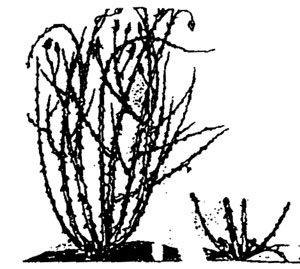 The second category is "moderate pruning" . The illustration at the right depicts the same plant after a moderate pruning. In this method, the canes are cut back to about 12-18 inches. Weaker than average canes should be reduced by more than this amount. This is the recommended pruning style for most HT’s and floribundas in home gardens. This method of pruning will result in a bush which will produce more flowers and a bigger plant during the current season but these flowers may be slightly smaller than if the rose was given a hard priming . The second category is "moderate pruning" . The illustration at the right depicts the same plant after a moderate pruning. In this method, the canes are cut back to about 12-18 inches. Weaker than average canes should be reduced by more than this amount. This is the recommended pruning style for most HT’s and floribundas in home gardens. This method of pruning will result in a bush which will produce more flowers and a bigger plant during the current season but these flowers may be slightly smaller than if the rose was given a hard priming .
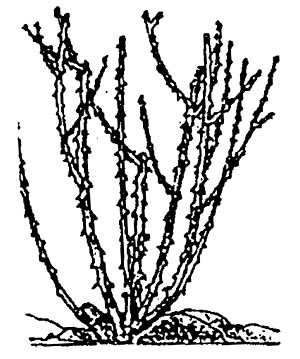 The third category of spring pruning is "light pruning". The illustration at the left depicts the same plant with light pruning. In light priming, the canes are cut back so that about two-thirds of their length still remains when the job is finished. Light pruning is not generally recommended because it often leads to tall, spindly bushes in our climate area. These bushes will bear blooms earlier in the year, but the blooms will often be of poor quality and without stems suitable for cutting or with insufficient girth to hold up the flowers. The third category of spring pruning is "light pruning". The illustration at the left depicts the same plant with light pruning. In light priming, the canes are cut back so that about two-thirds of their length still remains when the job is finished. Light pruning is not generally recommended because it often leads to tall, spindly bushes in our climate area. These bushes will bear blooms earlier in the year, but the blooms will often be of poor quality and without stems suitable for cutting or with insufficient girth to hold up the flowers.
Among the hybrid tea roses there seems to be at least one exception to moderate pruning being the best practice. Peace roses and their descendants seem to perform better if given a light pruning.
However, it is still wise to remove all the little and twiggy growth. The severity of pruning has less influence over the growth and flower production of the bush than we think, unless little to no pruning is done. When we have had severe winters in Portland, such that the majority of rose canes were killed all the way to the bud union, (to the ground), we have had some of our best spring rose shows, indicating that the bushes regrow rapidly. When winters are mild, many people are prompted to do only a light pruning on the roses since all of the canes are alive and sprouting. When pruning time approaches, there is already a lot of leafy growth and this is very difficult for many novice rose growers, and others, to remove during the pruning process. These lightly pruned bushes will produce lots of growth from the ends of relatively small canes. This growth will tend to be small in diameter and much of it may be broken off by the spring rains or by the weight of developing flowers. So, do not be afraid that you will over prune. It is almost always true that pruning too hard will produce better results than pruning too little.
Climbers need to be pruned differently. lf a climber is trained into a horizontal position, as illustrated in the diagram, the only pruning that should be done in the spring is to prune the laterals, the short upright shoots coming from the main canes. These laterals should be reduced in length by pruning such that only two or three bud eyes remain, which is usually about 2-4 inches. An alternate method is to completely remove the laterals, which will force the rose to produce new laterals from dormant eyes in the main cane.
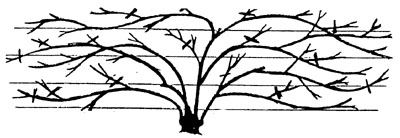 The areas of pruning are marked with slashes on the diagram. Also, any old canes that are detected as being unproductive (no vigorous growth being produced by them in the previous year) should be removed to the ground level. Any new canes should be trained by tying them into a horizontal position. Any additional pruning should be done only to shape the bush to fit the style that is desired and to keep it in bounds. The areas of pruning are marked with slashes on the diagram. Also, any old canes that are detected as being unproductive (no vigorous growth being produced by them in the previous year) should be removed to the ground level. Any new canes should be trained by tying them into a horizontal position. Any additional pruning should be done only to shape the bush to fit the style that is desired and to keep it in bounds.
Miniature roses are pruned in much the same way as hybrid tea roses, just on a smaller scale. Leave the healthy canes 4 to 8 inches long and remove all the twiggy growth. Miniatures are very vigorous and will respond well to severe pruning by producing g number of new basal breaks, ie., new stems originating from below the ground.
At this time, OGR’S and other one time bloomers, should be only lightly pruned to shape and control their size and to remove old unproductive wood. More pruning can be done, but these rose types produce their blooms on old wood and removing additional wood now reduces this year’s blooms. Save any major pruning on these roses until the blooming cycle is completed.
The English (David Austin’s) roses may be pruned like hybrid teas, but using the light to moderate pruning methods. Most of the English roses bloom on new wood so panning is done to produce a healthy base that can accommodate the current year’s growth just like HT’s, Floribundas etc. Basically, if they grow like a climber, prune them like a climber and if they grow like a hybrid tea rose, prune them like a hybrid tea.
To sum up for any rose plant - remove any parts of the bush that are too small or weak to hold up the growth anticipated for this year and leave as much strong wood as you want, the more you leave the bigger the bush will be.
Back to Top >>
|